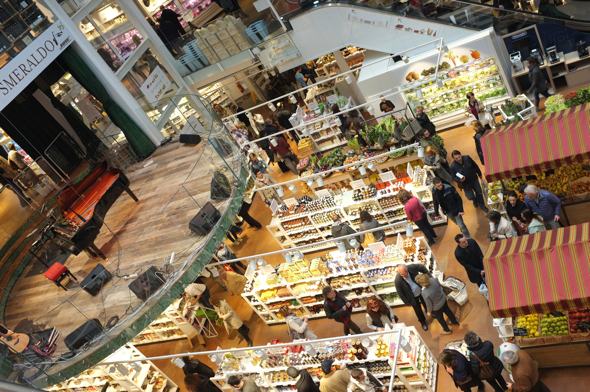Sustainability is a global concern, and Italy is taking significant strides towards going green. The importance of adopting sustainable practices has become crucial, considering the impact of climate change and the need for immediate action. In this context, local communities in Italy are at the forefront, driving change and implementing green initiatives. This article explores the various ways in which Italy is embracing sustainability and highlights the initiatives taken by locals. From renewable energy sources and waste management to sustainable agriculture and transportation, Italy is making significant progress. Supporting local businesses and products, as well as educating and engaging communities, are also key aspects of Italy’s sustainable journey. By understanding Italy’s approach to sustainability, we can gain valuable insight into effective strategies for a greener future.
The Importance of Going Green
In a world grappling with climate change, going green has become crucial. In this section, we’ll dive into the significance of embracing sustainability, exploring the impact of climate change and the pivotal role local communities play. Prepare to uncover eye-opening facts and figures as we delve into the imperative need for a greener future. Italy, a country leading the way in sustainable practices, serves as a poignant example of how locals are taking a proactive stance in creating a more environmentally conscious world.
The Impact of Climate Change
The Impact of Climate Change is having a significant influence both globally and in Italy. Rising temperatures, extreme weather events, and sea-level rise are just a few consequences that result from The Impact of Climate Change. These changes have a direct effect on ecosystems, agriculture, and human health. Italy has been experiencing longer and hotter summers, which has resulted in an increase in forest fires caused by The Impact of Climate Change. The concerning aspect of The Impact of Climate Change is how it affects Italy’s delicate ecosystems and cultural heritage. To address this issue, the government, local communities, and individuals are taking action to mitigate and adapt to The Impact of Climate Change. Initiatives such as sustainable agriculture, renewable energy sources, and promoting eco-friendly transportation are implemented to reduce The Impact of Climate Change in Italy.
The Role of Local Communities
Local communities in Italy play a crucial role in promoting sustainability. The role of local communities is essential in addressing environmental challenges and actively participating in green initiatives. They contribute to sustainability in various ways:
| Ways to Contribute to Sustainability |
|---|
| 1. Adopting renewable energy sources for powering homes and businesses. |
| 2. Practicing efficient waste management and recycling. |
| 3. Reducing carbon footprint by encouraging eco-friendly transportation options. |
| 4. Supporting local businesses that prioritize sustainable practices. |
| 5. Engaging in sustainable education programs and community outreach to spread awareness. |
By embracing these sustainable practices collectively, local communities in Italy are instrumental in creating a greener and more sustainable future for all. Some suggestions for individuals and communities include organizing clean-up drives, supporting local farmers’ markets, and advocating for stronger environmental policies.
Green Initiatives in Italy
Italy, known for its rich culture and breathtaking landscapes, is now making waves with its green initiatives. Dive into the world of sustainability and explore the different aspects of green living in Italy. From harnessing renewable energy sources to effective waste management and recycling practices, and strategies to reduce carbon footprint, this section peels back the layers of Italy’s eco-friendly approach, revealing the steps locals are taking to create a greener and more sustainable future.
Renewable Energy Sources
Renewable energy sources, such as hydropower, solar power, and wind power, play a crucial role in Italy’s sustainability efforts. Here are some key examples:
- Hydropower: Italy utilizes its abundant rivers to generate clean and renewable energy.
- Solar power: The country’s sunny climate is harnessed through photovoltaic panels installed on rooftops and in solar parks.
- Wind power: Italy has a significant number of wind farms, especially in coastal and mountainous regions.
Pro-tip: Consider installing solar panels on your own property to reduce reliance on traditional energy sources and contribute to a sustainable future.
Waste Management and Recycling
Waste management and recycling are crucial elements of sustainability efforts in Italy. The country has taken various initiatives to minimize waste and encourage recycling.
- Separation and Collection: Italians are encouraged to sort their waste into different categories like paper, plastic, and organic waste to optimize the recycling process.
- Recycling Infrastructure: Italy has established an extensive network of recycling facilities and collection points to ensure proper waste disposal and recycling.
- Circular Economy: The country has embraced the idea of a circular economy, where waste materials are transformed into valuable resources through recycling and upcycling.
- Reduce and Reuse: Italy promotes waste reduction by advocating for reusable packaging and supporting initiatives such as zero-waste supermarkets.
Reducing Carbon Footprint
To reduce your carbon footprint and contribute to a greener future for our planet, there are several steps you can take:
- Conserve energy by using energy-efficient appliances and light bulbs.
- Choose renewable energy sources like solar or wind power.
- Minimize water usage by taking shorter showers and fixing leaks.
- Use public transportation, carpool, or bike instead of driving alone.
- Reduce waste by recycling, composting, and avoiding single-use plastics.
- Eat a plant-based diet or reduce meat consumption.
- Support local and sustainable businesses and products.
By implementing these actions, you can significantly contribute to reducing your carbon footprint and ensuring a greener future for our planet.
Sustainable Agriculture and Farming Practices
Sustainable Agriculture and Farming Practices in Italy are paving the way for a greener future. From organic farming to local food production and preserving biodiversity, these practices are transforming the way we interact with our food systems. Discover how farmers and communities in Italy are adopting environmentally friendly methods, fostering a healthier planet and supporting sustainable living. Get ready to delve into the world of sustainable agriculture and witness the positive impact it has on both the environment and our well-being.
Organic Farming
Organic farming plays a vital role in the promotion of sustainable agriculture and the protection of the environment. Here are some significant aspects of organic farming:
- Use of natural fertilizers and pesticides, avoiding chemical inputs that can potentially harm soil and water quality.
- Promotion of biodiversity by preserving the habitat for beneficial insects, birds, and other wildlife.
- Emphasis on soil health through practices such as crop rotation and cover cropping, which enhance nutrient cycling and reduce erosion.
- Prohibition of genetically modified organisms (GMOs) and synthetic growth hormones in livestock.
- Strict adherence to certification standards, ensuring that organic products meet specific criteria for production and labeling.
Historically, organic farming practices date back to ancient civilizations where farmers relied on natural methods to cultivate crops. The modern organic farming movement gained momentum in the early 20th century with the rise of organic farming pioneers like Sir Albert Howard and Rudolf Steiner. Today, organic farming continues to gain popularity as consumers prioritize environmentally friendly and health-conscious options.
Local Food Production
Local food production is a key aspect of sustainability in Italy. It involves practices such as organic farming, preserving biodiversity, and supporting local businesses. Here is a table that highlights the importance and benefits of local food production:
| Benefits | Examples |
| Environmental Sustainability | – Reduces carbon emissions from transportation – Minimizes the use of synthetic pesticides and fertilizers |
| Economic Growth | – Supports local farmers and small-scale enterprises – Boosts local economy and job creation |
| Health and Nutrition | – Fresher and more nutritious produce – Reduced exposure to potentially harmful chemicals |
| Promotes Biodiversity | – Preserves traditional crop varieties and indigenous foods – Protects natural habitats and wildlife |
By embracing local food production, communities can contribute to a more sustainable and resilient food system. It is important to prioritize purchasing from farmers’ markets, supporting community-supported agriculture, and advocating for policies that promote local food production.
Preserving Biodiversity
Preserving biodiversity in Italy is of utmost importance for maintaining ecological balance and safeguarding native plant and animal species. Italy has implemented various initiatives to achieve this crucial goal. One notable initiative is the promotion of organic farming practices that reduce the reliance on pesticides and foster the conservation of natural habitats. Collaborative efforts between local authorities and conservation organizations are instrumental in establishing protected areas and nature reserves, effectively preserving biodiversity hotspots. It is also essential to actively involve local communities in conservation endeavors and educate them about the significance of biodiversity preservation. By preserving biodiversity, Italy ensures a sustainable future for its ecosystems and upholds the country’s natural splendor. A helpful tip is to support local farmers and opt for organic products as a means to contribute to biodiversity preservation.
Transportation and Sustainable Mobility

Stop reading, start speaking
Stop translating in your head and start speaking Italian for real with the only audio course that prompt you to speak.
With a focus on transportation and sustainable mobility, let’s explore how locals in Italy are embracing green practices. From efficient public transportation systems to the development of bicycle infrastructure and the promotion of electric vehicles, this section highlights the various ways Italians are embracing sustainable modes of transportation. Get ready to dive into the innovative solutions that are reshaping the way people move around in Italy.
Public Transportation Systems
Public transportation systems are essential to foster sustainability in Italy. They offer a more eco-friendly substitute to private vehicles, reducing both carbon emissions and traffic congestion. In Italy, there is a well-established and efficient network of public transportation that spans across cities and regions. For instance, Rome’s Metro system and Milan’s tram network are widely utilized by both locals and tourists. In addition, buses and trains that connect different cities are easily accessible. To further promote the use of public transportation, Italy should invest in expanding the network and improving connectivity to remote areas. It would be advantageous to implement smart ticketing systems and promote various modes of transportation, thereby increasing the convenience and appeal of using public transportation. Ultimately, these measures would contribute significantly to Italy’s journey towards a greener future.
Bicycle Infrastructure
Investing in bicycle infrastructure is fundamental for promoting sustainable transportation and reducing carbon emissions in cities.
Here is a comprehensive overview of the key components of bicycle infrastructure:
| Cycle Lanes | Designated lanes exclusively for bicycles, segregated from motor vehicle traffic. |
| Bicycle Parking | Secure and convenient parking facilities to encourage cycling as a mode of transportation. |
| Bicycle Sharing | Publicly available bicycles for short-term use, promoting accessibility and reducing private vehicle use. |
| Intersection Improvements | Features like bike boxes, advanced stop lines, and signal timing adjustments to enhance cyclist safety at intersections. |
| Signage and Markings | Clear and visible signs and road markings to guide cyclists and motorists and improve road safety. |
To further strengthen bicycle infrastructure, cities can prioritize regular maintenance, expand existing networks, and conduct public awareness campaigns promoting the benefits of cycling. By creating a safe and efficient cycling environment, cities can encourage more individuals to choose bicycles as a means of transportation, leading to reduced traffic congestion, improved air quality, and enhanced overall sustainability.
Promoting Electric Vehicles
Promoting electric vehicles is an essential aspect of sustainability efforts. Here are some actions to support their adoption:
- Infrastructure Development: Invest in establishing a widespread charging network to alleviate concerns about range anxiety.
- Financial Incentives: Offer subsidies or tax credits to promote the purchase of electric vehicles.
- Public Transportation: Incorporate electric buses and trains into public transit systems to decrease emissions.
- Education and Awareness: Conduct campaigns to inform the public about the advantages of electric vehicles, such as reduced emissions and noise pollution.
- Government Fleet Transition: Lead by example by transitioning government fleets to electric vehicles, highlighting their practicality.
By implementing these strategies, we can expedite the adoption of electric vehicles and contribute to a greener future.
Supporting Local Businesses and Products
Supporting local businesses and products in Italy is a powerful way to foster sustainability and reduce environmental impact. In this section, we’ll dive into the thriving world of small-scale enterprises, artisanal crafts, local markets, and fair trade. Discover how these vibrant facets of Italian culture not only contribute to the local economy but also promote sustainable practices and preserve traditional craftsmanship. Get ready to immerse yourself in the rich tapestry of unique businesses and products that are making a green difference in Italy.
Small-Scale Enterprises
Small-scale enterprises play a vital role in driving sustainability in Italy through their distinctive characteristics and approaches. These enterprises prioritize local resources, craftsmanship, and community engagement. Here are some essential aspects of
- Local focus: Small-scale enterprises prioritize sourcing their materials locally, reducing transportation emissions, and contributing to the local economy.
- Craftsmanship: These enterprises emphasize traditional and artisanal techniques, preserving cultural heritage, and minimizing the use of non-renewable resources.
- Social responsibility: Small-scale enterprises give priority to fair wages, safe working conditions, and community involvement, thereby fostering sustainable and inclusive development.
An exemplary illustration of Small-Scale Enterprises embracing sustainability is “Xilo1934“, a family-owned woodworking company in Italy. They actively incorporate locally sourced wood from sustainable forests, employ traditional craftsmanship, and involve the community in their creative processes. Xilo1934 actively promotes environmentally friendly practices and has become an inspiration for other Small-Scale Enterprises in Italy.
Artisanal Crafts
Artisanal crafts play a vital role in promoting sustainable practices and supporting local businesses in Italy. These traditional handmade products are crafted using time-honored techniques, often passed down through generations. They showcase the unique cultural heritage and skills of local artisans. By purchasing artisanal crafts, consumers contribute to the preservation of traditional craftsmanship and help create a more sustainable future. These products are often made from locally sourced materials, reducing carbon emissions associated with transportation. They also have a lower environmental impact compared to mass-produced items. Investing in artisanal crafts supports sustainable economic growth and helps maintain cultural diversity.
| Key Features of Artisanal Crafts | Importance |
| Handcrafted using traditional techniques | Preserves cultural heritage |
| Utilizes locally sourced materials | Reduces carbon emissions |
| Lower environmental impact compared to mass-produced items | Promotes sustainability |
| Supports local businesses and artisans | Drives sustainable economic growth |
| Preserves cultural diversity | Valuing traditional craftsmanship |
Local Markets and Fair Trade
Supporting local markets and fair trade is a crucial aspect of sustainable practices in Italy. By purchasing products from local markets, you not only contribute to the growth of the local economy but also play a part in reducing carbon emissions linked to long-distance transportation. Fairtrade ensures that producers are adequately compensated for their goods, thus promoting social and economic justice. By embracing these principles, we contribute to the preservation of cultural traditions, the protection of the environment, and the establishment of a more just society. Pro-tip: When shopping, be on the lookout for certifications like Fairtrade or labels indicating that products are locally sourced, as this supports local markets and the fair trade movement.
Educating and Engaging Communities
Italy is paving the way towards a greener future, and the key lies in educating and engaging communities. With sustainable education programs, active community involvement, and a focus on building a sustainable mindset, Italians are spearheading the movement towards sustainability. Discover how these initiatives are transforming local practices and inspiring individuals to take meaningful action for the environment. Get ready to delve into the exciting world of educating and engaging communities in the journey towards a more sustainable Italy.
Sustainable Education Programs
“`
Sustainable education programs, such as the ones mentioned in the provided text, play a key role in promoting sustainability and creating awareness among individuals and communities. These programs are designed to educate and engage people in adopting environmentally friendly practices and developing a sustainable mindset.
- One way to incorporate sustainability into education is through curriculum integration. This involves incorporating sustainability topics and concepts into educational curricula at all levels.
- Experiential learning is another valuable approach. It involves providing hands-on experiences, such as field trips to sustainable farms or renewable energy facilities, to help students understand sustainability in a practical and tangible way.
- Community engagement is vital for promoting sustainability. Encouraging communities to participate in sustainability projects and initiatives fosters a sense of responsibility and empowers individuals to become active contributors to a sustainable future.
- Providing teacher training is essential for equipping educators with the necessary knowledge and tools to effectively integrate sustainability into their teaching practices.
- Establishing student-led environmental clubs within schools can be an effective way to promote sustainability within the school community and raise awareness about environmental issues.
- Partnerships with local organizations and businesses can create valuable opportunities for students to learn about sustainability in real-world contexts. Collaborating with these entities allows students to see the practical applications of sustainability and understand its importance beyond classroom learning.
Community Involvement and Outreach
Community involvement and outreach are crucial factors in promoting sustainability in Italy. There are several ways in which communities can actively engage in green initiatives:
| 1. Community clean-up events should be organized to encourage waste reduction and proper recycling practices. |
| 2. Establishing community gardens is a great way to promote local food production and support sustainable agriculture efforts. |
| 3. Collaborating with local schools to implement sustainability education programs for students helps raise awareness and foster eco-consciousness. |
| 4. Supporting and participating in local sustainability-focused events, such as eco-fairs or workshops, showcases a community’s commitment to sustainable living. Sustainability in Italy: How Locals are Going Green |
| 5. It is also important to form community-based initiatives that advocate for environmentally-friendly policies and practices. |
Let me share a true story from a small Italian town where residents successfully came together to create an effective recycling program. They initiated educational sessions and utilized informative campaigns to engage the community. As a result, recycling rates experienced a significant boost, leading to a cleaner and more sustainable environment for all.
Building Sustainable Mindset
Building a sustainable mindset is crucial for embracing sustainable practices and creating a greener future. Here are some ways to cultivate a sustainable mindset:
- Educate yourself on sustainability issues through workshops, courses, or online resources.
- Engage with your community by participating in local sustainability initiatives and events.
- Practice mindful consumption by choosing environmentally friendly products and reducing waste.
- Promote sustainable habits within your household, such as conserving energy and water.
- Support businesses that prioritize sustainability and ethical practices.
- Advocate for sustainable policies and regulations at the local, national, and global levels.
By actively working towards building a sustainable mindset, we can make a significant impact in creating a more sustainable and resilient future for all.


.jpg)




